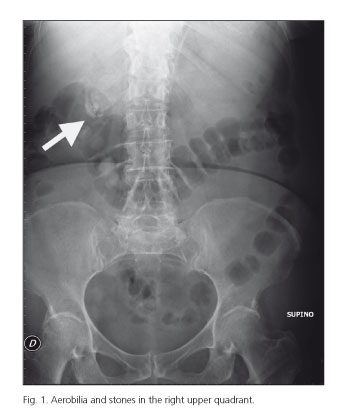Mi SciELO
Servicios Personalizados
Revista
Articulo
Indicadores
-
 Citado por SciELO
Citado por SciELO -
 Accesos
Accesos
Links relacionados
-
 Citado por Google
Citado por Google -
 Similares en
SciELO
Similares en
SciELO -
 Similares en Google
Similares en Google
Compartir
Revista Española de Enfermedades Digestivas
versión impresa ISSN 1130-0108
Rev. esp. enferm. dig. vol.108 no.7 Madrid jul. 2016
PICTURES IN DIGESTIVE PATHOLOGY
A rare presentation of gallstones: Bouveret's syndrome, a case report
Síndrome de Bouveret
Lander Gallego-Otaegui, Aitor Sainz-Lete, Rodrigo Gutiérrez-Ríos, Maialen Alkorta-Zuloaga, Xabier Arteaga-Martín, Raúl Jiménez-Agüero, Miguel Ángel Medrano-Gómez, Inmaculada Ruiz-Montesinos and Adolfo Beguiristain-Gómez
Unit of Hepatobiliopancreatic Surgery. Department of General and Digestive Surgery. Hospital Universitario Donostia. San Sebastián, Guipúzcoa. Spain
Case report
An 84-year-old female consulted for epigastric pain. His personal history included hypertension and cholelithiasis with a previous admission for acute cholecystitis treated medically a year before. Besides pain, she reported solid food intolerance, tolerating fluids well. Physical examination showed only generalized abdominal distention and bloating.
Abdominal plain film revealed calcifications projected on the right upper quadrant in relation to already known cholelithiasis and aerobilia (Fig. 1). The patient was admitted to hospital to complete the study. A gastroscopy was performed where a retention stomach and impaction of a large gallstone, suggestive of a Bouveret's syndrome, were observed (Fig. 2). Endoscopic removal and fragmentation of the gallstone were impossible, so an abdominopelvic CT scan was performed to determine the stone location (Fig. 3).
In accordance with these findings, the decision was made to operate by open surgery. A large gallstone impacted in the second duodenal portion, which caused a pressure ulcer, with fibrotic adhesions to the gallbladder, was observed. A longitudinal gastrostomy of about 6 cm was made in the gastric body for manual removal of the impacted gallstone (Fig. 4). After the procedure, the patient progressed well, being discharged 7 days later, to be followed up in the outpatients department.
Discussion
Bouveret's syndrome is a rare form of gallstone ileus caused by the passage and impaction of a large gallstone through a cholecysto-duodenal fistula in the duodenum, resulting in gastric outlet obstruction. It was first described in 1896 by Léon Bouveret (Lyon, France). Gallstone ileus is responsible for 1-4% of all cases with small bowel obstruction and the location of these in the duodenum occurs only in 1-3% of cases (1,2). It usually occurs in elderly women, with an average age of 70-75 years and is generally due to a large gallstone (single stone in > 90%) within the pyloric channel or duodenum (3).
The clinical symptoms are nonspecific; the most common symptoms are described as a triad of epigastric pain, nausea and vomiting (3).
Clinical suspicion is essential for diagnosis. The abdominal plain film is diagnostic in only 21% of cases (Rigler triad: small bowel obstruction, pneumobilia, and an ectopic gallstone). Ultrasound is useful to exclude accompanying cholecystitis. CT scan is the diagnostic method in 60% of cases, which can be complemented by a cholangio-RM, because 15-25% of stones are isodense (1,4). The gallstone is endoscopically visible in only 70% of cases, probably because the mucosa covers the embedded stone. In 20-40% of cases the final diagnosis is made during surgery.
Various endoscopic or percutaneous methods have been described for treatment (mechanical, laser, intra/extracorporeal electrohydraulic lithotripsy, etc.) (5-7). Despite these options, surgery remains the first treatment option and 91% of patients will need surgery during the disease. Historically, surgery has been reduced to an enterolithotomy or stone extraction by gastrotomy. Cholecystectomy and simultaneous fistula repair is another option, but it is reserved for patients with low surgical risk, when the anatomy is not hostile, and for patients with concomitant acute cholecystitis or gallbladder empyema (3). Due to the age and comorbidity of patients, Bouveret's syndrome has a morbidity of 60% and a mortality of 12-30% (3).
References
1. Puri V, Lee RW, Amirlak BA, et al. Bouveret syndrome and gallstone ileus. Surg Laparosc Endosc Percutan Tech 2007;17:328-30. DOI: 10.1097/SLE.0b013e31806c7dc2. [ Links ]
2. Englert ZP, Love K, Marilley MD, et al. Bouveret syndrome: Gallstone ileus of the duodenum. Surg Laparosc Endosc Percutan Tech 2012;22:e301-3. DOI: 10.1097/SLE.0b013e318262ec13. [ Links ]
3. Felix Nickel, Matthias M Müller-Eschner, Jackson Chu, et al. Bouveret's syndrome: Presentation of two cases with review of the literature and development of a surgical treatment strategy. BMC Surgery 2013;13:33. DOI: 10.1186/1471-2482-13-33. [ Links ]
4. Gijón-de-la-Santa L, Camarero-Miguel A, Pérez-Retortillo JA, et al. Bouveret's syndrome: Evaluation with multidetector CT. Rev Esp Enferm Dig 2014;106:283-4. [ Links ]
5. Kaushik N, Moser AJ, Slivka A, et al. Gastric outlet obstruction caused by gallstones: Case report and review of the literature. Dig Dis Sci 2005;50:470-3. DOI: 10.1007/s10620-005-2460-9. [ Links ]
6. Langhorst J, Schumacher B, Deselaers T, et al. Successful endoscopic therapy of a gastric outlet obstruction due to a gallstone with intracorporeal laser lithotripsy: A case of Bouveret's syndrome. Gastrointest Endosc 2000; 51:209. DOI: 10.1016/S0016-5107(00)70421-4. [ Links ]
7. Gemmel C, Weickert U, Eickhoff A, et al. Successful treatment of gallstone ileus (Bouveret's syndrome) by using extracorporal shock wave lithotripsy and argon plasma coagulation. Gastrointest Endosc 2007;65:173. DOI: 10.1016/j.gie.2006.05.025. [ Links ]











 texto en
texto en 





